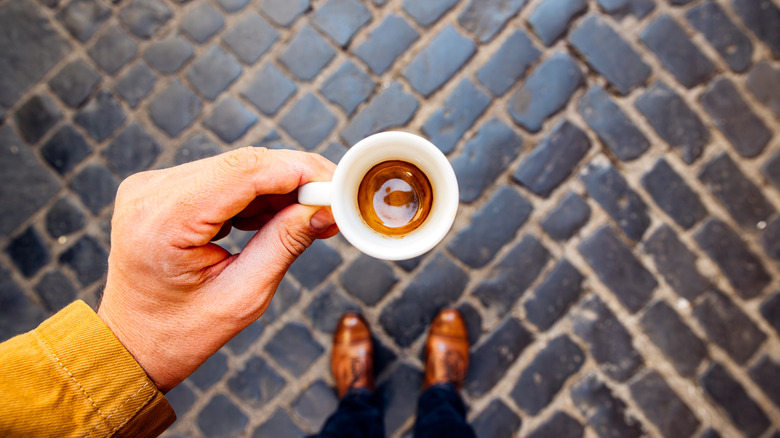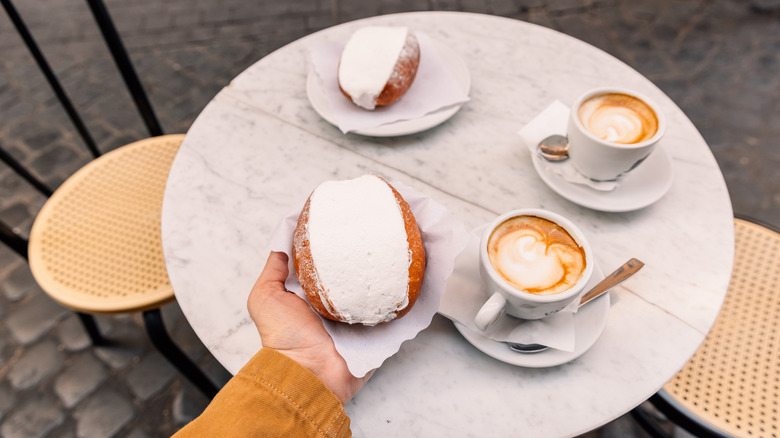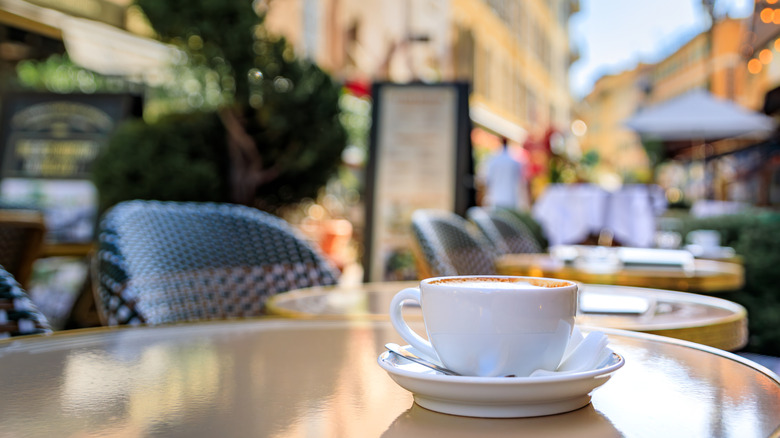Rick Steves Shares The Most Crucial Coffee Etiquette Secrets To Know Before A Trip To France Or Italy
You need your morning joe no matter where you go. At the same time, coffee drinkers have very particular preferences, even if it's just as simple as pouring hot brown liquid in a cup. So what do travelers do when going to a new place bereft of their go-to coffee option? Whine and complain? Or, do what travel author Rick Steves says and learn local ways? This is especially true for two European countries with very specific and centuries-old coffee cultures: France and Italy.
As Steves explains on his website, following unspoken rules to dine (or drink) like a local in France and Italy doesn't just include what to order, but also when and why. For the Americans in the house, this means foregoing any notions of endless diner mugs of watery auto-drip brews. This is similar to foregoing ordering tap water in certain European countries. You order once and get one coffee, that's it. And "coffee" doesn't mean the glass decanter stuff sloshed into a ceramic cup. "Coffee" means any kind of drink made from coffee beans, but typically espresso or cappuccino. Americanos or other milk-based coffees like macchiatos exist, but as a second-tier option. And also: Take five minutes and sit down rather than do the paper cup-carrying thing.
On the whole, you've got three times during the day when you drink coffee, and the time determines the type of drink. Milk-based coffees, particularly cappuccinos, are breakfast drinks. Espresso and/or espresso with a little milk (a macchiato) is fine in the afternoon, maybe while sitting at an al fresco table and engaging in that favorite Parisian pastime of people-watching. And of course, espresso after dinner is common. Everything else is considered a bit unusual.
What coffee to order where, when and why
As Rick Steves explains, it's easiest to think of French and Italian coffee etiquette in terms of times of day. Before noon, you've got your milk-based coffees. In Italy, this is the famed cappuccino or a caffè latte. In France, it's a café au lait and/or café crème. Of course, at this point in history, it's not like you can't get a cappuccino or latte in France; it's just that those two French options are more traditional to the country. So take your pick early in the day, but keep it milky, or else Italian (and French) locals may give you the side-eye if you place this common coffee order in the afternoon.
There's a simple rationale behind this custom: Folks believe that milk-based coffees after a meal upset the stomach. You can order a caffè macchiato in Italy or a noisette in France later in the afternoon, which only has a little milk in it. Although you can order what you want, it might not be in accordance with local customs. That is, you can order everything except an American-style cup of diner coffee. That's just not going to happen.
As for the non-milk coffees, you've got a caffè americano in Italy or a café allongé in France. Both of these are just espresso with water added to make them easier on the palate or gentler on the stomach. Then there's straight espresso, which folks in both Italy and France typically have after dinner. And while this all might sound a bit prescriptive, Italy's been drinking coffee since the 16th century via the Ottoman Empire and France since the mid-1700s through — you guessed it — Venice, Italy. They know what they're doing.
Other helpful French and Italian coffee rules
Now we come to an assortment of other coffee etiquette applicable to both Italy and France, starting with the key one that'll blow the minds of uninitiated American tourists: no to-go drinks. We're talking no giant paper or styrofoam cup with a plastic lid, no cup holders in SUVs, and also no SUVs. This is more serious than you might think, as a nice coffee should be considered on par with a nice wine, meal, or anything else. To an Italian or French person, you're fundamentally defying the purpose of having a nice coffee if you thoughtlessly blow through it and chug it on the go and then chuck the container somewhere. Unfortunately, you may incur a table charge for even sitting just for a coffee, but that's how it goes. Best do as locals do and let the moment linger.
There are other little bits of coffee etiquette related to Italy, like having a moka coffee in the morning if you want a real, authentic Italian household experience. This isn't a typical item you'll find in a cafe, but more something you can find in a small, privately-owned hotel where you can make a special request. A moka is a little stove-top pot that contains water and coffee and which drives steam through the coffee to make a really strong, thick brew. It's most similar in body to Turkish coffee, which Rick Steves mentions on his website. Turkish coffee boils water and grounds together to leave a muddy layer of compacted grounds underneath a really strong, rich coffee. If you're up for this in either Italy or France, give it a go. As Steves would tell you, it's best to do what the locals do.


